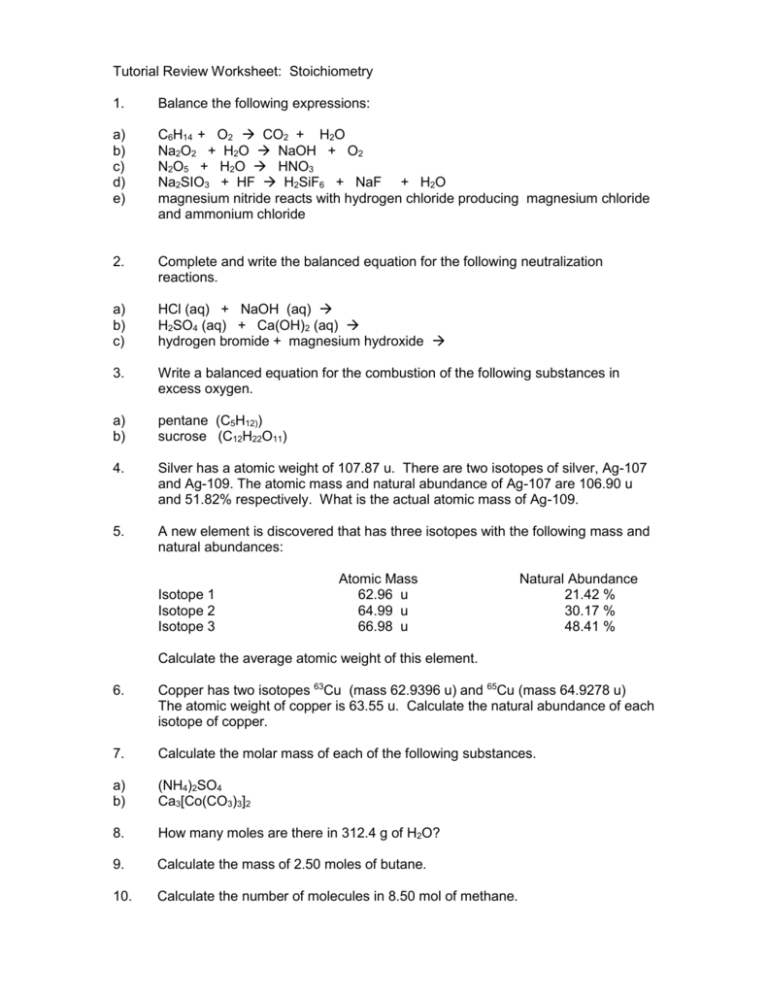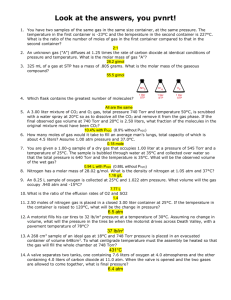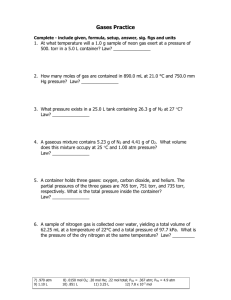Review Worksheets
advertisement

Tutorial Review Worksheet: Stoichiometry 1. Balance the following expressions: a) b) c) d) e) C6H14 + O2 CO2 + H2O Na2O2 + H2O NaOH + O2 N2O5 + H2O HNO3 Na2SIO3 + HF H2SiF6 + NaF + H2O magnesium nitride reacts with hydrogen chloride producing magnesium chloride and ammonium chloride 2. Complete and write the balanced equation for the following neutralization reactions. a) b) c) HCl (aq) + NaOH (aq) H2SO4 (aq) + Ca(OH)2 (aq) hydrogen bromide + magnesium hydroxide 3. Write a balanced equation for the combustion of the following substances in excess oxygen. a) b) pentane (C5H12)) sucrose (C12H22O11) 4. Silver has a atomic weight of 107.87 u. There are two isotopes of silver, Ag-107 and Ag-109. The atomic mass and natural abundance of Ag-107 are 106.90 u and 51.82% respectively. What is the actual atomic mass of Ag-109. 5. A new element is discovered that has three isotopes with the following mass and natural abundances: Isotope 1 Isotope 2 Isotope 3 Atomic Mass 62.96 u 64.99 u 66.98 u Natural Abundance 21.42 % 30.17 % 48.41 % Calculate the average atomic weight of this element. 6. Copper has two isotopes 63Cu (mass 62.9396 u) and 65Cu (mass 64.9278 u) The atomic weight of copper is 63.55 u. Calculate the natural abundance of each isotope of copper. 7. Calculate the molar mass of each of the following substances. a) b) (NH4)2SO4 Ca3[Co(CO3)3]2 8. How many moles are there in 312.4 g of H2O? 9. Calculate the mass of 2.50 moles of butane. 10. Calculate the number of molecules in 8.50 mol of methane. 11. Calculate the number of hydrogen atoms in 4.20 x 1020 molecules of ethanol. 12. Calculate the number of hydrogen atoms in 0.75 mol of benzene. 13. Calculate the number of CO molecules in a 20.0 g sample of CO. 14. Calculate the mass of 1.50 x 1024 molecules of C7H6O2. 15. Calculate the number of carbon atoms in 20.0 g of C6H14O4. 16. The molecular formula of benzene is C6H6. Calculate the mass of benzene that must be weighted out in order to have a sample containing 5.20 x 1024 hydrogen atoms. 17. Calculate the mass of one cobalt atom (in grams). 18. Calculate the mass of carbon in 5.86 g of butane. 19. What is the % by mass of each element in the following substances? a) b) (C5H5)2Fe Ba3(PO4)2 20. Calculate the mass of oxygen in a 25.0 g sample of glucose, C6H12O6. 21. Orlon consists of 67.9% C, 5.7 % H and 26.4 % N by mass. What is the empirical formula of orlon? 22. An oxide of iron contains 6.99 g of iron and 3.01 g of oxygen. Calculate the empirical formula of this oxide. 23. Glycerin contains only the elements carbon, hydrogen and oxygen. When a sample weighing 1.250 g is combusted, 1.793 g of carbon dioxide and 0.979 g of water are formed. What is the empirical formula of glycerine. 24. Calculate the theoretical yield of NaOH when 4.0 g of Na2O2 is reacted with excess water according to the unbalanced expression: Na2O2 25. + H2O H2O2 + NaOH Given the following balanced equation: 3 Fe + 2 O2 Fe3O4 Calculate the following quantities when 3.00 mol of O2 is consumed: a) b) c) d) moles of Fe3O4 produced moles of Fe needed to completely consume all the O2 the mass of Fe3O4 produced the mass of Fe required for the reaction 26. Given the following unbalanced equation Al a) b) + O2 Al2O3 c) balance the equation calculate the theoretical yield of Al2O3 when 81.0 g of aluminum reacts with excess oxygen If only 106 g of Al2O3 actually forms, what is the percentage yield? 27. Given the unbalanced expression: C4H6 + HBr C4H8Br2 Calculate the moles of C4H8Br2 produced when 1.50 mol of HBr is mixed with 0.50 mol of C4H6. 28. Given the balanced equation: 5 SF4 + 2 I2O5 4 IF5 + 5 SO2 a) b) c) Calculate the theoretical yield of IF5 when 10.0g of SF4 and 10.0 g of I2O5 react. Which substance is the limiting reagent? Which substance is present in excess and how much remains left unreacted? 29. If 72.5 g of potassium nitrate are dissolved in water to make a total solution with a volume of 1.5 x 103 mL. What is the molarity of the potassium nitrate in this solution? 30. A student was required to prepare 500.0 mL of a 0.200 M NaNO3 solution. Describe what the student would have to do to make this solution. 31. A student weighs out 50.0 g of NaBr. If the student wants to make a 0.25 M NaBr solution, what should be the total volume of the final solution? 32. In an experiment 250.0 mL of 0.125 M NaCl solution is added to 375 mL of 0.234 M Na2SO4 solution. What is the sodium ion concentration in this solution? 33. A solution is prepared by adding 25.0 mL of commercial HCl to water. The resulting solution has a total volume of 250.0 mL. The density of the commercial HCl solution is 1.19 g/mL, and it is 36.8 % HCl by weight. Calculate the molarity of HCl in this solution. 34. Commercial sulphuric acid is 96.0 % sulphuric acid by mass and has a density of 1.84 g/mL. What is the molarity of commercial sulphuric acid? 35. What is the total volume of solution that must be prepared if one dilutes 45.0 mL of 6.00 M HNO3 to produce a 1.20 M HNO3 solution? 36. An impure sample of ferrous ammonium sulphate hexahydrate, (NH4)2Fe(SO4)2●6H2O, is titrated with 0.0164M potassium dichromate according to the net ionic equation: 14 H+ + 6 Fe2+ + Cr2O72- 2 Cr3+ + 6 Fe 3+ + 7H2O If a 1.61 g sample oft the impure ferrous ammonium sulphate requires 38.2 mL of potassium dichromate solution, what was the % ferrous ammonium sulphate in the sample? 37. An unknown solid acid is dissolved in 25 mL of water and titrate with KOH. Assume that the balanced equation shows a 1:1 molar ratio of solid acid and KOH. If 1.0443 g of solid acid reacts completely with 51.1 mL of 0.100 M KOH, what is the molar mass of the solid acid? 38. In an experiment 12.5 mL of 0.200 M AgNO3 solution is reacted with 0.125 M CaCl2 solution. What volume of CaCl2 is required to precipitate all the chloride ions? 39. Use the solubility rules to determine whether the following ionic solids are soluble or insoluble in water. a) b) c) d) e) f) barium sulphate ammonium nitrate rubidium hydroxide silver bromide sodium carbonate calcium phosphate 40. Using the solubility rules, write the net ionic equations for the following reactions: a) sodium sulfate plus potassium chloride produces sodium chloride plus potassium sulfate silver nitrate plus potassium iodide produces silver iodide and potassium nitrate b) 41. Using the solubility rules, write net ionic equations for the reactions which occur (if any) when the following aqueous solutions are mixed. a) b) magnesium chloride and sodium hydroxide silver nitrate and sodium iodide 42. Convert 10.0 torr to atmospheres. 43. The pressure of an ideal gas in a 25.3 L container is 1.75 atm. If the pressure of the gas is increased to 2000.0 torr at constant temperature what is the new volume of the gas? 44. A sample of an ideal gas at 25 0C and 764 torr occupies a volume of 975 mL. If the volume is changed to 2.50 L at 764 torr, what is the new temperature of the gas? 45. A gas sample in a 7.25 L container exerts a pressure of 1.35 atm at 18 0C. If the sample is heated at constant volume until a pressure of 1500.0 torr is attained, what is the new temperature of the gas? 46. The pressure exerted by 45.0 g of nitrogen gas in a closed vessel is 2315 torr. If the volume and temperature remain constant, how can a pressure of 1.5 atm be attained in the vessel? 47. What mass of Cl2 gas is added to 0.112 mole of chlorine gas in a 2.50 L container at STP if the volume of the container is expanded to 6.25 L at STP by the addition of the extra chlorine gas? 48. A sample of an ideal gas is held at constant pressure in a fixed 5.00 L container. If 1.50 mole of the ideal gas at 39.0 0C is heated to 78 0C, how many moles of the ideal gas must be let out of the container to maintain the constant pressure? 49. A gas sample in a 3.20 L container at a temperature of 324 0C exerts a pressure of 1.80 atm. What volume will the gas occupy at STP? 50. When 2.10 mol of an ideal gas occupies a volume of 1.8 L at a temperature of 50.0 0C, what is the pressure that will be exerted by the gas? 51. What is the temperature of 0.205 mol of an ideal gas that occupies a volume of 5.25 L at a pressure of 1320 torr? 52. What is the volume occupied by 75.0 g of ammonia gas at a temperature of 150.0 0C and a pressure of 1000.0 torr? 53. A gas has a density of 0.725 g/L at 22.0 0C and a pressure of 1.033 atm. What is the molar mass of the gas? 54. A 4.25 g sample of an ideal gas occupies a volume of 1250 mL at 100.0 0C and a pressure of 707 torr. What is the molar mass of the gas? 55. Chemical analysis of an unknown gas determined it was 92.3 % carbon and 7.7 % hydrogen by weight. In a second experiment, a 0.832 sample of the unknown gas was introduced into a 400 mL container at 10 0C at a pressure of 1.73 atm. What is the molecular formula of the gas? 56. For the reaction 2 SO2 (g) + O2 (g) 2 SO3 (g) What volume of SO3 (g) can be produced from 16.0 L of O2 gas if both gases are measured at the same temperature and pressure? 57. What mass of LiO2 (s) is needed to produce 2.50 L of oxygen gas at 30 0C and 768 torr according to the reaction 4 LiO2 (s) + 2 CO2 (g) 2 Li2CO3 (s) + 3 O2 (g) 58. A 20.0 L flask contains 12.0 g of SO2 (g) and 12.0 g of SO3 (g) at 25 0C. What is the total pressure inside the flask? 59. Given the reaction Zn (s) + 2 HCl (aq) ZnCl2 (aq) + H2 (g) 2.50 g of solid zinc are reacted with 250.0 mL of 0.150 M HCl solution. The H2 gas produced was collected over water at 32.0 0C (the vapour pressure of water at 32.0 0C is 35.4 torr) If 479 mL of water were displaced by the H2 (g), what is the total pressure above the displaced water/H2 (g) container? 60. At what temperature will O2 (g) molecules have the same root mean square velocity as SO3 (g) at 125 0C? 61. The rate of effusion of an unknown gas is 1.98 ft/min and the rate of effusion of SO3 (g) is 1.13 ft/min. What is the molar mass of the unknown gas? Solutions 1. a) b) c) d) e) 2. a) HCl (aq) + NaOH (aq) NaCl (aq) + H2O (l) b) H2SO4 (aq) + Ca(OH)2 (aq) CaSO4 (s) + 2 H2O (l) c) 2 HBr + Mg(OH)2 MgBr2 + 2 H2O 3. a) C5H12 + 8 O2 5 CO2 + 6 H2O b) C12H22O11 + 12 O2 12 CO2 + 11 H2O 4. 5. 6. 7. 108.9 u 65.53 u Cu – 63 : 69.4% Cu – 65: 30.6% a) 132.16 g/mol b) 598.16 g/mol 17.34 mol 145 g 5.12 x 1024 molecules 2.52 x 10 21 H atoms 2.7 x 1024 4.30 x 1023 304 g 4.81 x 1023 C atoms 112 g 9.78 x 10-23 g per Co atom 4.84 g of C a) %C = 64.55 , % H = 5.43 , % Fe = 30.02 b) % Ba = 68.45, % P = 10.29, % O = 21.26 13.3 g C3H3N Fe2O3 C3H8O3 4.1 g a) 1.50 mol b) 4.50 mol c) 347 g d) 251 g a) 4,3,2 b) 153 g c) 69.3% 0.50 mol a) 13.3 g b) I2O5 c) 1.9 g of SF4 in excess 0.48 M weigh 8.50 g of NaNO3 transfer to 500 mL volumetric flask, add about 200 mL of distilled water, swirl to dissolve, fill to etch mark, stopper and mix thoroughly 1.9 L 0.331 M 8. 9. 10. 11. 12. 13. 14. 15. 16. 17. 18. 19. 20. 21. 22. 23. 24. 25. 26. 27. 28. 29. 30. 31. 32. 2,19,12,14 2,2,4,1 1,1,2 1,8,1,2,3 Mg3N2 + 8 HCl 3 MgCl2 + 2 H2O 33. 34. 35. 36. 37. 38. 39. 40. 41. 42. 43. 44. 45. 46. 47. 48. 49. 50. 51. 52. 53. 54. 55. 56. 57. 58. 59. 60. 61. 1.20 M 18.0 M 225 mL 91.3 % 204 g/mol 0.0100L a) insoluble b) soluble c) soluble d) insoluble e) soluble f) insoluble a) no reaction b) Ag+ (aq) + I- (aq) AgI (s) 2+ a) Mg (aq) + 2OH (aq) Mg(OH)2 (s) b) Ag+ (aq) + I- (aq) AgI (s) 0.0132 atm 16.8 L 764 K 425 K release 23.0 g of N2 (P2/P1 = n2/n1) 11.9 g 0.17 mol 2.63 L 30.9 atm 543 K 116 L 17.0 g/mol 112 g C2H2 32.0 L 5.29 g 0.412 atm 1.030 atm / 782.5 torr 159 K 26.1 g/mol









